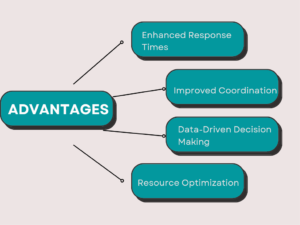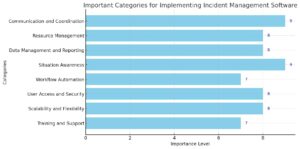Incident management software is a fundamental component in coordinating incident responses across various types of events. Its role is especially crucial in today’s world, where the frequency and intensity of natural disasters have significantly increased compared to the past.
Effective disaster management, encompassing both natural and man-made incidents, involves substantial risks. A proper response can prevent loss of life, minimize property damage, and facilitate a swift return to normalcy for affected communities.
This blog discusses the critical importance of Incident Management Software (IMS) in disaster response, detailing its features, benefits, and implementation strategies.
Understanding Incident Management Software
Incident Management Software (IMS) is designed to enable organizations to handle emergencies efficiently. This system is essential for reporting, monitoring, and managing incidents across various fields. It acts as a command center for disaster management, integrating functionalities like communication, information dissemination, resource management, data interpretation, and analysis to enhance response rates.
| Understanding Incident Management Software | |
| Feature | Characteristics |
| Real-time Communication and Coordination | Alert the senders and receivers of data and thus controllers and administrators of responses |
| Resource Management | Helps to effectively allocate resources all through a given chain |
| Incident Tracking and Reporting | Track and report all the specific occurrences |
| Integration with other Systems | Function together with other helpful systems |
Let us identify the salient features of IMS and how an IT infrastructure solution provider can help in detail:
- Real-time Communication & Coordination
Disaster response management depends on positive communication hence it is important to adopt effective communication platforms. IMS founded Interactive Distance Education and e-learning tools such as messaging systems, video conferencing, and an alert system. These features alert the senders and receivers of data and thus controllers and administrators of responses coordinate timeously.
- Resource Management
Resource management is vital in a disaster and should be managed efficiently for the best results. IMS can be used to track and distribute work such as the distribution of human resources, machinery, facilities, and other materials. It also helps to effectively allocate resources all through a given chain, to ensure that demand for a certain resource in a certain sector is met.
- Incident Tracking and Reporting
Another aspect is the efforts to track and report all the specific occurrences that may have occurred during a particular phase of the incident. IMS allows for the thorough record-keeping of details, maps and the status, which are critical in near-shore and post-impact scenarios.
- Integration with Other Systems
Today’s IMS solutions can function together with other helpful systems like a Geographic Information System, Meteo System, and Public Address System. It also gives a holistic approach to the occurrence of incidents when it has been integrated, hence improving the decision-making process.
Advantages of Incident Management Software

A few of the advantages of incident management software are listed below:
- Enhanced Response Times
IMS significantly reduces the time required to respond to inquiries and emergencies. With features like real-time feeds and dispatch options, responders gain rapid situational awareness and can mobilize relevant resources quickly, thereby minimizing the disaster’s impact.
- Improved Coordination
Disaster response often involves multiple agencies and organizations. IMS facilitates better coordination among these entities by providing a shared platform for communication and resource management. This common ground improves the overall efficiency and effectiveness of the response.
- Data-Driven Decision Making
Disaster response often involves multiple agencies and organizations. IMS facilitates better coordination among these entities by providing a shared platform for communication and resource management. This common ground improves the overall efficiency and effectiveness of the response.
- Resource Optimisation
IMS helps organizations optimize the utilization of their resources. By keeping track of available human resources, equipment, and materials, IT solutions like IMS ensures that resources are used efficiently and effectively. This optimization minimizes resource wastage and ensures timely emergency responses.
Implementing Incident Management Software
By keeping in mind the following aspects, we can successfully implement incident management software:
- Assessing Organisational Needs
Before one can start to implement IMS certain prerequisites need to be met. It’s about determining the kind of incidents that will be claimed, the tools to be used, and other systems that IMS will be interfacing with. The choice of the software and its features will be informed by the needs of the organisation undergoing the audit.
- Selecting the Right Software
In the present world market, there are numerous IMS solutions available with their advantages and disadvantages. Choosing the right software might be based on characteristics such as convenience, capacity for expansion, compatibility with other systems, and the availability of further services.

- Customise and Integrate the System
If an IMS solution has been chosen, the next step is to make it compliant with your specific needs. You need to adopt the applications to meet the unique requirements of your company and its business management. Also on dependability, the ability to interface with other systems is important for the response functions.
- Training and Drills
IMS, from the prospect of their implementation, is not only a question of technology but rather of people as well. Make sure all users who are expected to be on the system are trained well on how to handle it. Essential frequent exercises also include drills and simulations. Both assist in evaluating the performance of the system and examining the level of awareness of the responders.
Conclusion
The application of Incident Management Software can be considered as a key strategy to strengthen the resilience of an organisation in the face of disaster situations. Through enhanced communication, resource dispatch and other analytical solutions, IMS enhances real-time reactions and responses to emergencies.
We, at SCS Tech India PVT Ltd offer leading-edge, advanced software IT infrastructure solutions for managing incidents and ensuring smooth, efficient operations. Our exceptional technologies are designed for swift and efficient responses to critical events. Our software provides real-time data, communication systems, and automated workflows to enhance emergency planning and enable quick, efficient actions by the emergency teams.
Contact us today to boost your organisation’s disaster management capabilities, increasing your safety and preparedness for any emergency.
